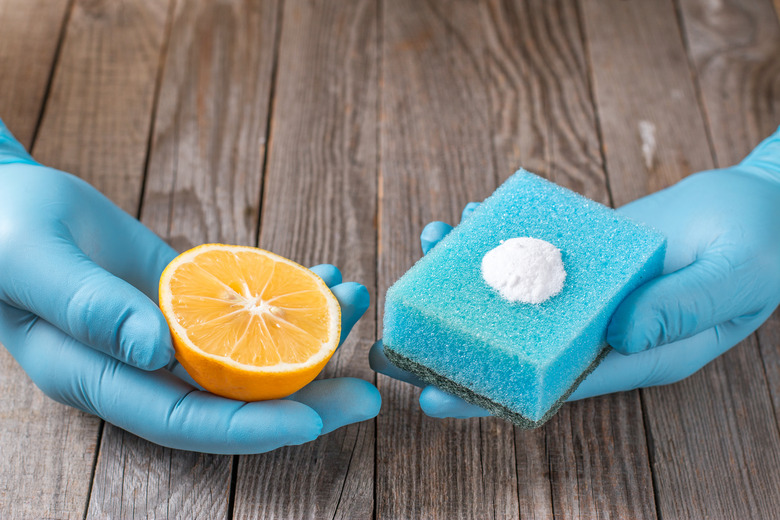What Happens When An Acid & A Base Are Combined?
Chemists have three separate theories for what constitutes an acid and a base, but there's no disagreement on the fact that they neutralize each other. When they combine in a water solution, they produce a salt. Acids and bases can combine in other ways, however, and when they do, the product isn't always a salt. For example, when you add zinc to ammonia, the reaction results in a complex ion. Until the introduction of the Lewis theory of acids and bases, this wouldn't even have been considered an acid/base reaction.
TL;DR (Too Long; Didn't Read)
In aqueous solutions, acids and bases combine to neutralize each other and produce a salt. Acid-base reactions that do not occur in water usually also produce salts, but they may also produce complex ions.
Acids Donate H+; Bases donate OH-
Acids Donate H+; Bases donate OH-
According to a theory advanced by Svante Arrhenius. a Nobel prize-winning physicist and chemist, an acid in solution donates an H+ ion in water. The ions don't float around freely, but instead attach themselves to water molecules to form hydronium ions (H3O+). The pH of a solution, which refers to the "power of hydrogen," is a measure of the number of these ions present. pH is a negative logarithm of concentration, so the lower the pH, the higher the concentration of these ions, and the more acidic the solution. Bases, on the other hand, donate hydroxide (OH-) ions. When a solution has a preponderance of hydroxide ions, its pH is above 7 (the neutral point), and the solution is alkaline. Acids and bases that behave this way are known as Arrhenius acids and bases. Hydrogen chloride (HCl) is an example of an Arrhenius acid, and sodium hydroxide (NaOH) is an Arrhenius base.
Arrhenius Acids and Bases Combine to Form Salts
Arrhenius Acids and Bases Combine to Form Salts
When you combine an Arrhenius acid and base in the same solution, the positively charged hydronium ions combine with the hydroxide ions to produce water, and the leftover ions combine to produce a salt. If all the available ions combine in this way, the solution becomes pH-neutral, which means that the acid and base neutralize each other. The best-known example is dissolving hydrogen chloride and sodium hydroxide in solution to produce free sodium (Na+) and chloride (Cl-) ions. They combine to form NaCl, or common table salt. This process is called hydrolysis.
Brønsted-Lowry Generalizes the Acid/Base Reaction
Brønsted-Lowry Generalizes the Acid/Base Reaction
A pair of chemists, Johannes Nicolaus Brønsted and Thomas Martin Lowry, independently introduced a more generalized conception of acids and bases in 1923. In their theory, an acid is a compound that donates a proton (H+) while a base is a compound that accepts one. This conception extends the Arrhenius definition to account for acid-base reactions that don't occur in aqueous solution. For example, according to the the Brønsted-Lowry definition, the reaction between ammonia and hydrogen chloride to produce the salt ammonium chloride is an acid-base reaction that doesn't involve the exchange of hydronium or hydroxide ions. It would not be considered an acid-base reaction under the Arrhenius definition. Bronsted-Lowry acid-base reactions don't always produce water, but they still produce salts.
Lewis Generalizes Even More
Lewis Generalizes Even More
Also in 1923, G.N. Lewis from UC Berkeley modified the definition of acids and bases to account for reactions that couldn't be explained using the Brønsted-Lowry conception. In Lewis' theory, bases are electron-pair donors while acids are electron-pair acceptors. This conception helps explain reactions that occur, not only between solids and liquids but also gases, as acid-base reactions. In this theory, the product of the reaction may not be a salt. For example, the reaction between zinc ions and ammonia produces tetraamminezinc, a complex ion.
Zn2++4NH3→[Zn(NH3)4]4+.
References
- Shodor: Acid-Base Chemistry
- ThoughtCo: Arrhenius Acid Definition and Examples
- ThoughtCo: Bronsted Lowry Theory of Acids and Bases
- Chemistry LibreTexts: Brønsted Concept of Acids and Bases
- Chemistry LibreTexts: Lewis Concept of Acids and Bases
- Chemistry LibreTexts: Overview of Acids and Bases
- University of Sydney Faculty of Science: CHEM1902/4 Answers to Problem Sheet 11
Cite This Article
MLA
Deziel, Chris. "What Happens When An Acid & A Base Are Combined?" sciencing.com, https://www.sciencing.com/happens-acid-base-combined-5132830/. 26 April 2018.
APA
Deziel, Chris. (2018, April 26). What Happens When An Acid & A Base Are Combined?. sciencing.com. Retrieved from https://www.sciencing.com/happens-acid-base-combined-5132830/
Chicago
Deziel, Chris. What Happens When An Acid & A Base Are Combined? last modified August 30, 2022. https://www.sciencing.com/happens-acid-base-combined-5132830/
